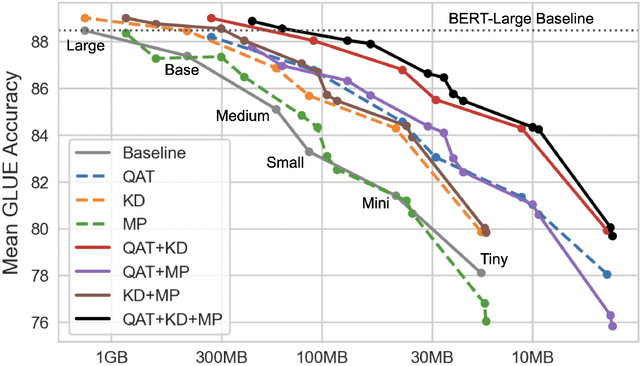Chris DuBois
Combining Compressions for Multiplicative Size Scaling on Natural Language Tasks
Aug 20, 2022


Abstract:Quantization, knowledge distillation, and magnitude pruning are among the most popular methods for neural network compression in NLP. Independently, these methods reduce model size and can accelerate inference, but their relative benefit and combinatorial interactions have not been rigorously studied. For each of the eight possible subsets of these techniques, we compare accuracy vs. model size tradeoffs across six BERT architecture sizes and eight GLUE tasks. We find that quantization and distillation consistently provide greater benefit than pruning. Surprisingly, except for the pair of pruning and quantization, using multiple methods together rarely yields diminishing returns. Instead, we observe complementary and super-multiplicative reductions to model size. Our work quantitatively demonstrates that combining compression methods can synergistically reduce model size, and that practitioners should prioritize (1) quantization, (2) knowledge distillation, and (3) pruning to maximize accuracy vs. model size tradeoffs.
Active Learning Over Multiple Domains in Natural Language Tasks
Feb 08, 2022



Abstract:Studies of active learning traditionally assume the target and source data stem from a single domain. However, in realistic applications, practitioners often require active learning with multiple sources of out-of-distribution data, where it is unclear a priori which data sources will help or hurt the target domain. We survey a wide variety of techniques in active learning (AL), domain shift detection (DS), and multi-domain sampling to examine this challenging setting for question answering and sentiment analysis. We ask (1) what family of methods are effective for this task? And, (2) what properties of selected examples and domains achieve strong results? Among 18 acquisition functions from 4 families of methods, we find H-Divergence methods, and particularly our proposed variant DAL-E, yield effective results, averaging 2-3% improvements over the random baseline. We also show the importance of a diverse allocation of domains, as well as room-for-improvement of existing methods on both domain and example selection. Our findings yield the first comprehensive analysis of both existing and novel methods for practitioners faced with multi-domain active learning for natural language tasks.
Entity-Based Knowledge Conflicts in Question Answering
Sep 10, 2021



Abstract:Knowledge-dependent tasks typically use two sources of knowledge: parametric, learned at training time, and contextual, given as a passage at inference time. To understand how models use these sources together, we formalize the problem of knowledge conflicts, where the contextual information contradicts the learned information. Analyzing the behaviour of popular models, we measure their over-reliance on memorized information (the cause of hallucinations), and uncover important factors that exacerbate this behaviour. Lastly, we propose a simple method to mitigate over-reliance on parametric knowledge, which minimizes hallucination, and improves out-of-distribution generalization by 4%-7%. Our findings demonstrate the importance for practitioners to evaluate model tendency to hallucinate rather than read, and show that our mitigation strategy encourages generalization to evolving information (i.e., time-dependent queries). To encourage these practices, we have released our framework for generating knowledge conflicts.
An Exploration of Data Augmentation and Sampling Techniques for Domain-Agnostic Question Answering
Dec 04, 2019



Abstract:To produce a domain-agnostic question answering model for the Machine Reading Question Answering (MRQA) 2019 Shared Task, we investigate the relative benefits of large pre-trained language models, various data sampling strategies, as well as query and context paraphrases generated by back-translation. We find a simple negative sampling technique to be particularly effective, even though it is typically used for datasets that include unanswerable questions, such as SQuAD 2.0. When applied in conjunction with per-domain sampling, our XLNet (Yang et al., 2019)-based submission achieved the second best Exact Match and F1 in the MRQA leaderboard competition.
* Accepted at the 2nd Workshop on Machine Reading for Question Answering
 Add to Chrome
Add to Chrome Add to Firefox
Add to Firefox Add to Edge
Add to Edge